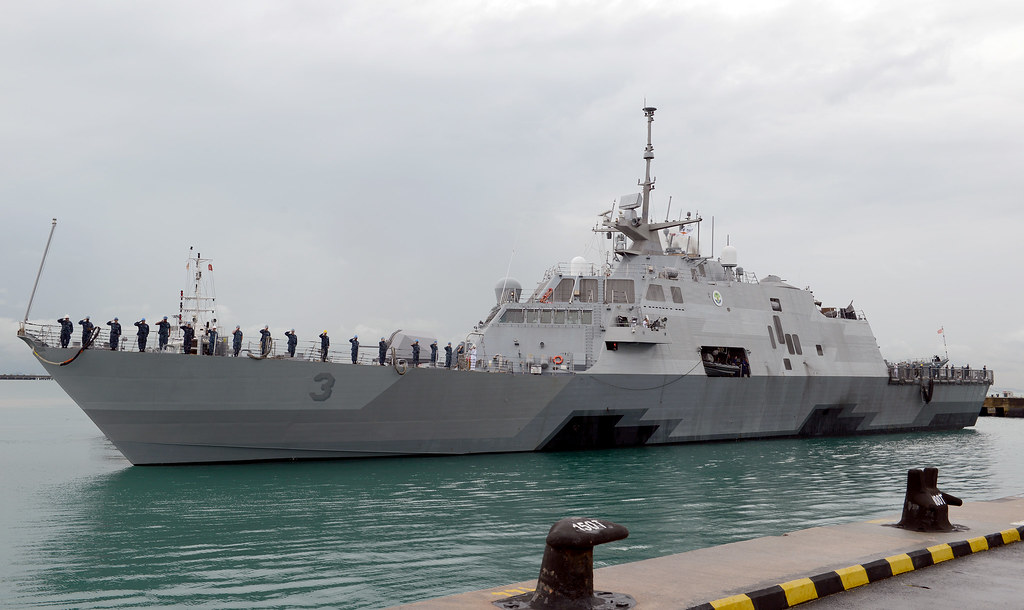 |
| The littoral combat ship USS Fort Worth (LCS 3) (Source: US Pacific Fleet) |
CHANGI NAVAL BASE, Singapore - The littoral combat ship USS Fort Worth (LCS 3) returned to Singapore April 15 after a two-month stint operating in Northeast Asia and Southeast Asia.
Singapore is the maintenance and logistics hub for rotationally deployed LCSs and Fort Worth returned to port to conduct a planned maintenance availability.
"It's been a 'tour of firsts' for Fort Worth, and the LCS program as a whole, as the ship operated throughout Northeast Asia for the first time," said Capt. Fred Kacher, commodore, Destroyer Squadron 7. "Through the hard work and ingenuity of our Sailors on board Fort Worth, each and every day we are realizing the true operational potential of LCS and are learning how best to employ these ships here in US 7th Fleet."
Since departing Singapore in February after the first of three crew swaps, Fort Worth has completed two of her deployment milestones, which included participation in exercise Foal Eagle 2015 with the Republic of Korea Navy and a routine planned maintenance availability in Sasebo, Japan. Both events underscore Fort Worth's growing operational reach throughout US 7th Fleet.
"I couldn't be more proud of the entire crew of Fort Worth for successfully completing two of our deployment milestones," said Cmdr. Matt Kawas, Fort Worth Crew 103 commanding officer. "Crew 103, along with the surface warfare mission package and air detachment, have time and time again proved that LCS has a strong future here in the Indo-Asia-Pacific region and I look forward to rounding out our deployment with the same amount of success."
Prior to returning to Singapore, Fort Worth participated in Naval Engagement Activity (NEA) Vietnam with the Vietnam People's Navy April 6-10, as both nations celebrated the 20th anniversary of diplomatic relations in 2015. NEA Vietnam is designed to foster mutual understanding, build confidence in the maritime domain and strengthen relationships between the US Navy, Vietnam People's Navy and the local community.
During the five-day engagement, subject-matter expert exchanges focused on maritime domain awareness, shipboard damage control, submarine rescue, band concerts, community service events, and team sports. A brief at-sea phase allowed ships from both navies to practice the Code for Unplanned Encounters at Sea (CUES) and ship handling.
"I was really excited to get the chance to come back to Vietnam where I was born," said Operations Specialist 2nd Class Peter Tassani. "Participating in community service events with the local community and engaging with the Vietnam People's Navy as a US Navy Sailor was a great experience, and I hope to get the opportunity to do it again one day."
Fort Worth will depart Singapore again after her maintenance period and return for the International Maritime Defense Exhibition and Conference (IMDEX) 2015 just ahead of the next crew swap in late May.
Throughout the summer and fall, Fort Worth will take part in most of the 2015 Cooperation Afloat Readiness and Training (CARAT) exercise series. In its 21st year, CARAT is an annual, bilateral exercise series with the US Navy, US Marine Corps and the armed forces of nine partner nations including, Bangladesh, Brunei, Cambodia, Indonesia, Malaysia, the Republic of Philippines, Singapore, Thailand and Timor-Leste.
Fast, agile and mission-focused, littoral combat ships are designed to operate in near-shore environments and employ modular mission packages that can be configured for surface warfare, mine countermeasures or anti-submarine warfare.
Fort Worth will employ the surface warfare (SUW) mission package for her entire deployment, augmenting her 57mm gun and rolling airframe missile launcher with two 30mm guns, two 11-meter rigid-hull inflatable boats, and two six-member maritime security boarding teams. Enhancing the SUW mission package is the embarked aviation detachment from Helicopter Maritime Squadron (HSM) 35, the Navy's first composite expeditionary helicopter squadron, which consists of one MH-60R Sea Hawk helicopter and one MQ-8B Fire Scout unmanned aircraft system. The Fire Scout complements the MH-60R by extending the HSM-35's range and endurance, enhancing maritime domain awareness.
The US 7th Fleet conducts forward-deployed naval operations in support of US national interests in the Indo-Asia-Pacific area of operations. As the US Navy's largest numbered fleet, US 7th Fleet interacts with 35 other maritime nations to build partnerships that foster maritime security, promote stability and prevent conflict.

No comments:
Post a Comment